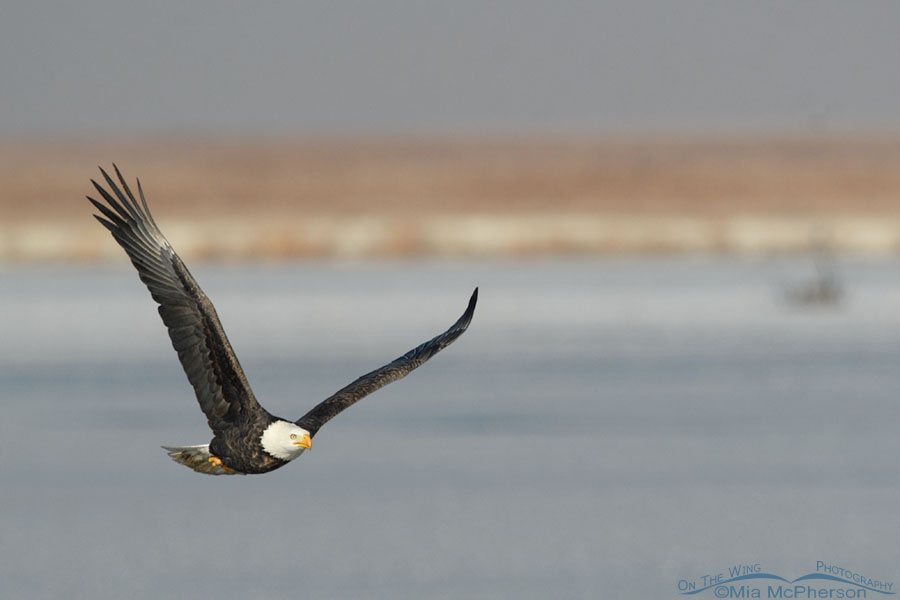 Adult Bald Eagle in flight over the frozen marsh at Farmington Bay WMA – Nikon D500, f7.1, 1/2500, ISO 500, Nikkor 500mm VR with 1.4x TC, natural light, not baited
Adult Bald Eagle in flight over the frozen marsh at Farmington Bay WMA – Nikon D500, f7.1, 1/2500, ISO 500, Nikkor 500mm VR with 1.4x TC, natural light, not baited
Right after I photographed the male Northern Harrier I shared photos of yesterday an adult Bald Eagle lifted off from the ice in a frozen section of the marsh yesterday at Farmington Bay WMA. I took a series of photos of the Bald Eagle as it flew towards the northeast and honestly I would have been much happier with my photos if they had been taken on a clearer day rather than on a day when the inversion was bad. And the inversion that morning was bad.
The Utah state government though has told the EPA that they have our air pollution under control. Yeah? No. They don’t.
There are times during the winter that the Salt Lake Valley area has THE worst air on the planet. That gray haze at the top of this photo is the inversion. The sky shouldn’t look like that.
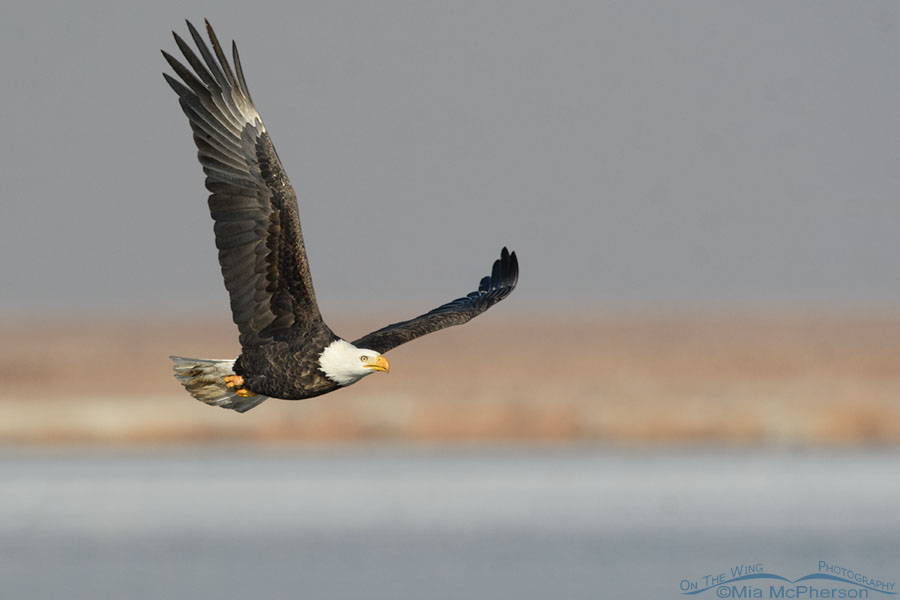 Adult Bald Eagle turning in flight – Nikon D500, f7.1, 1/2500, ISO 500, Nikkor 500mm VR with 1.4x TC, natural light, not baited
Adult Bald Eagle turning in flight – Nikon D500, f7.1, 1/2500, ISO 500, Nikkor 500mm VR with 1.4x TC, natural light, not baited
What is the “inversion” and why does it occur?
From the Utah.gov site:
Under normal atmospheric conditions, air is warmer near the ground and colder at higher altitudes. In a temperature inversion, the situation “inverts,” and cold air at the surface gets trapped under a layer of warmer air. During the winter, snow-covered valley floors reflect rather absorb heat, preventing the normal vertical mixing of warm and cold air that keeps pollutants from building up to unhealthy levels at the surface.
Causes
Calm winds, clear skies, and long nights prevent air at higher altitudes from mixing with air closer to the ground.
- Calm winds reduce the natural mixing of cold and warm air.
- Clear skies increase the rate of cooling of the air close to the ground.
- Long nights allow the cooling of the ground to continue over a longer period of time, resulting in a greater decrease in temperature near the surface.
- The sun is lower on the horizon during the winter, so it supplies less warmth to the earth’s surface and more to the atmosphere.
Mountains can also increase the strength of inversions in the valleys. The Wasatch Mountains, Oquirrh Mountains, and Traverse Mountain, for example, form a basin that traps cold air in the Salt Lake Valley and shields it from the stronger winds aloft that could clear out inversions.
There was zero snow on the ground two days ago or the day before that but the sky was filled with pollutants and haze from the inversion both mornings. The inversion did affect my image quality and made my head hurt too.
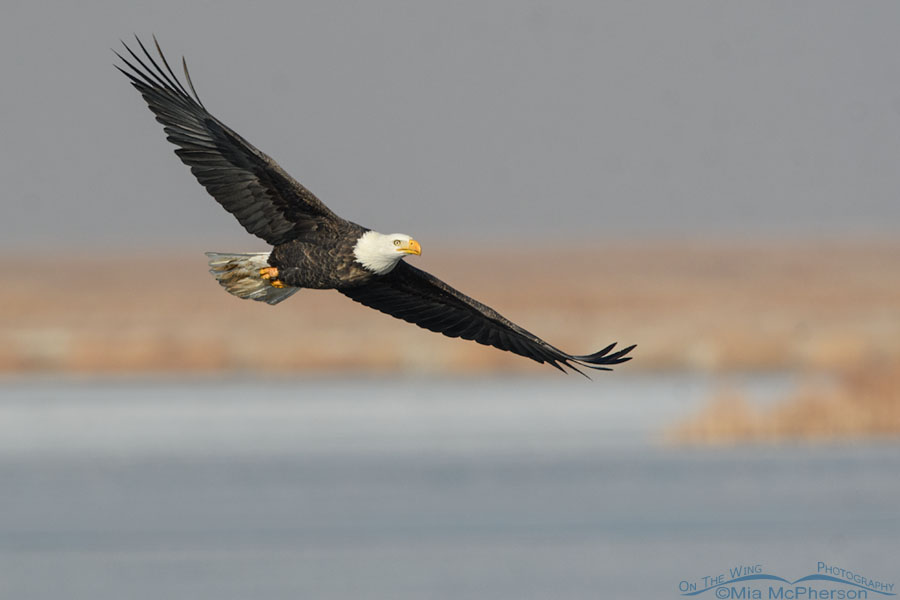 Adult Bald Eagle with its wings fully spread – Nikon D500, f7.1, 1/2500, ISO 500, Nikkor 500mm VR with 1.4x TC, natural light, not baited
Adult Bald Eagle with its wings fully spread – Nikon D500, f7.1, 1/2500, ISO 500, Nikkor 500mm VR with 1.4x TC, natural light, not baited
Because Farmington Bay WMA is well known for Bald Eagles during the winter I often get emails asking me if the eagles have arrived, how many there are, and what the best time is to make a trip here to photograph them.
Well the Bald Eagles are arriving but not in high numbers yet, usually they are here in higher numbers in January and at least part of February.
The inversions get worse during those months because the likelihood of snow being on the ground is much higher too. When making a trip to the Salt Lake Valley to photograph the wintering Bald Eagles I believe people need to seriously consider their health and well being. Our inversions can really mess with people who have asthma, COPD, breathing difficulties and allergies.
I personally have a multitude of allergies and the inversions mess with my sinuses and cause bad to severe headaches. Our inversions make it hard for healthy people to breathe.
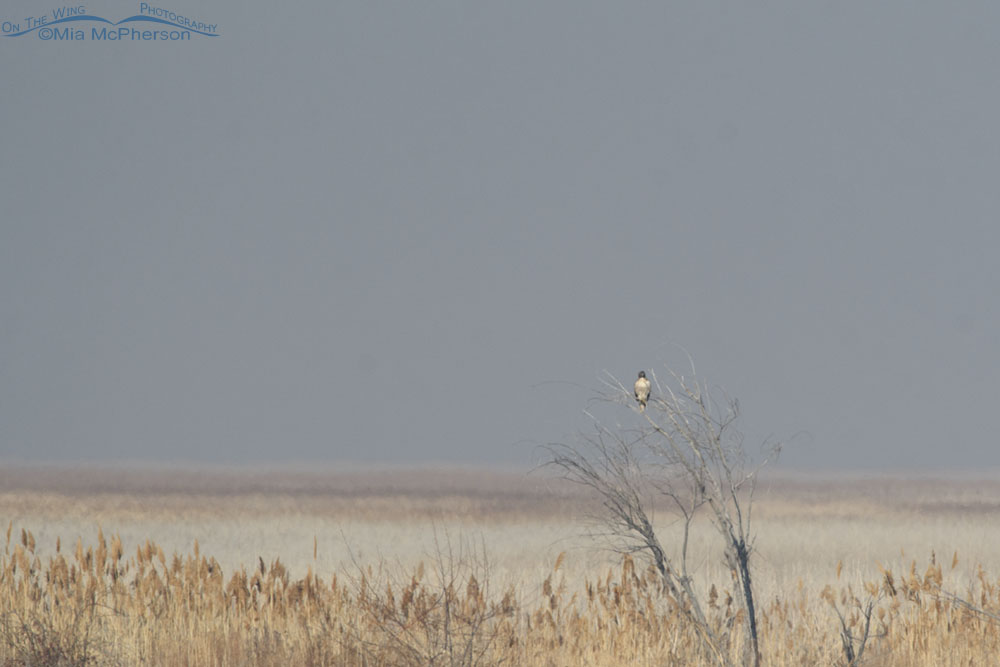 Red-tailed Hawk in the marsh during an inversion – Nikon D500, f7.1, 1/3200, ISO 500, Nikkor 500mm VR with 1.4x TC, natural light, not baited
Red-tailed Hawk in the marsh during an inversion – Nikon D500, f7.1, 1/3200, ISO 500, Nikkor 500mm VR with 1.4x TC, natural light, not baited
This long distance photo of a Red-tailed Hawk perched on a tree way out in the marsh was taken the same morning and in the same general area that I photographed the Bald Eagle images above. I took the photo as documentation and because I ID birds from a distance then take an image to test and make sure my long distance ID skills are up to my own standards.
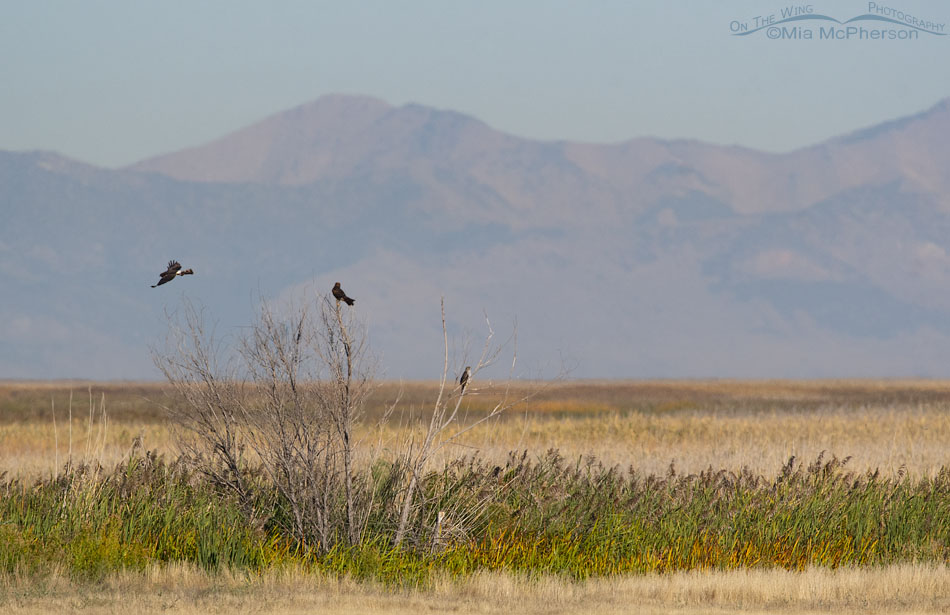 Northern Harriers and a Cooper’s Hawk on a September morning at Farmington Bay WMA – Nikon D500, f7.1, 1/2500, ISO 500, Nikkor 500mm VR with 1.4x TC, natural light, not baited
Northern Harriers and a Cooper’s Hawk on a September morning at Farmington Bay WMA – Nikon D500, f7.1, 1/2500, ISO 500, Nikkor 500mm VR with 1.4x TC, natural light, not baited
The photo above with two Northern Harriers and one Cooper’s Hawk was taken in the same general location that I photographed the Bald Eagle and the Red-tailed Hawk last year on September 26th at Farmington Bay WMA. The day was clearer but it was not what I would call a perfectly clear day. In the background the mountains on Antelope Island can be seen, even the marsh vegetation is crisper and sharp.
The comparison of the two bottom photos speak for themselves, don’t they?
We should be able to see those mountains in my Bald Eagle and Red-tailed Hawk photos that were taken two days ago. We don’t because of the inversion and the particulates in the air.
The Utah state government does not have a handle on our air quality. Not even close.
Life is good. It could be better here in the Salt Lake Valley if our state government cared more about the health of Utahns and worked on truly getting a handle on the inversions. Instead they are backing the construction of an inland port which will only make our air quality worse and our inversions stronger and longer.
Think carefully before you make a trip to Utah to photograph our overwintering Bald Eagles in the valley. The inversions are awful and can be life threatening.
Me? I’ll head up into the mountains where the air is clearer and even though the numbers of Bald Eagles are reduced up there I will be able to breathe with some peace of mind while I photograph them.
Mia
Click here to see more of my Bald Eagle photos plus facts and information about this species.
Have a look at the different air quality by varying elevations in the Wasatch Mountains and driving down I-80 into the valley. I was NOT driving at the time I took these photos. Taken on February 13, 2016. The composite image is too long in height to share here on this post.


Some images make you happy to be alive. This set of Bald Eagle and Hawk pics just did that for me. Simply beautiful birds! Thanks Mia.
As for poor air quality…California wrote the book. Even here in San Diego, where the air is almost pristine compared to LA, Fresno and the Bay Area, the particulates are terrible. But isn’t it that way nearly everywhere in the U.S. these days? Until our respective State governments begin to take the threat of air and water pollution as seriously as they have Covid… it ain’t gonna get no better. As Pogo famously said, ” We have met the enemy and he is us.”
Geographical factors mean that we live with an inversion factor too. Last summer when nearby fires were raging it added a whole new degree of difficulty for too many people.
I am glad that you could see and capture the Bald Eagles but feel for and with you.
Beautiful shots, nicely composed!
Valley doldrums.
i wasn’t sure of the meaning of inversion but you explained and showed it well. I am living now on the 11th floor and definitely see the layer of smog on some days. Nice captures of the eagle and hawks.
Oops– I meant to say the juvenile and other immature eagles migrate north in the summer, usually around July– actually they return in early to mid. winter.
We have the opposite type of “inversion” here in Florida, and it is why our Bald Eagles migrate north instead of south in the winter. The fish retreat to deeper and cool oxygen-rich water during the summer, making them more difficult for the (especially the younger) eagles to catch. As cold fronts with heavy rain come through in the winter, the surface of our lakes cools and since cold water is more dense, it breaks through and sinks to the bottom, a so-called “turnover.” The sediment from the bottom of the lake is stirred up and suddenly exposed to sunlight, creating a high oxygen demand. This can cause stress to the many exotic fish and there cam be a die-off, to the delight of the vultures and gulls. Can’t blame this on the government!